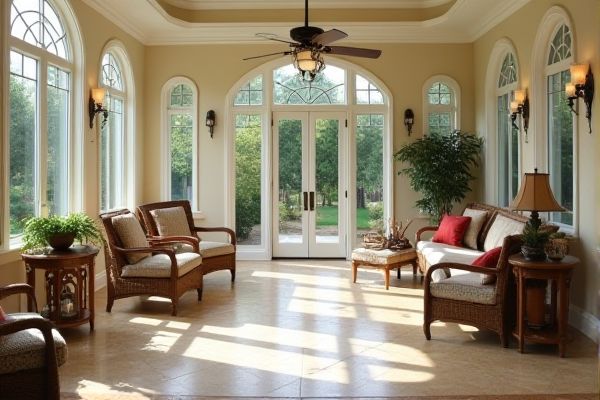
Tile offers superior durability and moisture resistance, making it ideal for sunrooms exposed to sunlight and temperature fluctuations, while laminate provides a budget-friendly, easy-to-install option with a variety of aesthetic choices but may suffer from water damage over time. Discover which flooring choice best suits your sunroom's needs and enhances your living space by reading the rest of the article.
Table of Comparison
| Feature | Tile Flooring | Laminate Flooring |
|---|---|---|
| Durability | Highly durable and resistant to scratches and stains | Moderately durable, prone to scratches and water damage |
| Water Resistance | Excellent, ideal for sunrooms exposed to moisture | Limited, can warp or swell with moisture exposure |
| Maintenance | Low maintenance; easy to clean with a mop | Requires regular cleaning; sensitive to water and spills |
| Comfort | Cool underfoot, less comfortable without rugs | Warmer and softer, mimics wood feel |
| Installation | Complex; requires professional installation | Easy DIY installation with click-lock planks |
| Cost | Higher upfront cost and installation fees | More affordable with lower installation cost |
| Aesthetic Appeal | Variety of designs; classic and elegant look | Wood-like appearance; modern and versatile |
| Longevity | Lasts 20+ years with proper care | Typically lasts 10-15 years |
Tile vs Laminate Sunroom Flooring: An Overview
Tile sunroom flooring offers superior durability, moisture resistance, and a wider variety of design options compared to laminate, making it ideal for sunrooms exposed to fluctuating temperatures and humidity. Laminate provides cost-effective installation, easy maintenance, and realistic wood-like aesthetics but may suffer from swelling and warping if moisture exposure is excessive. Choosing between tile and laminate hinges on factors such as sunroom climate control, budget, and desired aesthetic longevity.
Durability Comparison: Tile vs Laminate in Sunrooms
Tile flooring offers superior durability in sunrooms due to its resistance to moisture, scratches, and temperature fluctuations compared to laminate. Laminate flooring, while more affordable and easier to install, can warp or swell when exposed to high humidity and direct sunlight typical in sunroom environments. Choosing tile ensures long-lasting performance and minimal maintenance in sunroom spaces prone to varying weather conditions.
Moisture Resistance: Which Is Better for Sunrooms?
Tile flooring offers superior moisture resistance for sunrooms, effectively preventing water damage and mold growth due to its non-porous surface and ability to withstand humidity. Laminate flooring, while visually appealing and cost-effective, tends to absorb moisture over time, leading to potential swelling or warping in high-humidity environments common in sunrooms. Choosing tile ensures your sunroom remains durable and easy to maintain, protecting your investment from moisture-related issues.
Aesthetic Appeal: Style Options for Tile and Laminate
Tile sunroom flooring offers a wide range of style options, including natural stone, ceramic, and porcelain, providing a sleek and elegant aesthetic that can mimic traditional or modern designs. Laminate flooring delivers a versatile selection of patterns and wood-look finishes, enabling you to achieve the warmth and texture of hardwood at a lower cost and easier installation. Your choice between tile and laminate can enhance the sunroom's visual appeal, balancing durability with the style that best complements your space's decor.
Cost Analysis: Tile vs Laminate Installation and Maintenance
Tile sunroom flooring typically involves higher upfront costs due to expensive materials and professional installation, while laminate offers a more budget-friendly alternative with easier DIY installation. Maintenance expenses for tile can be lower in the long run because of its durability and resistance to moisture, whereas laminate may require periodic replacement or repairs due to susceptibility to water damage. Evaluating your sunroom's use and environment helps determine whether tile's durability justifies its cost or if laminate's affordability better suits your project.
Comfort Underfoot: Temperature and Feel Differences
Tile sunroom flooring offers a cool, hard surface that stays temperature-stable, making it ideal for warmer climates but potentially less comfortable during colder months. Laminate flooring provides a warmer, softer feel underfoot with better insulation properties, enhancing comfort when you spend extended time in your sunroom. Your choice depends on prioritizing temperature regulation and tactile comfort to match your sunroom's environment and use.
Installation Process: Ease of Tile versus Laminate
Tile flooring installation in a sunroom involves precise subfloor preparation and professional grout application, requiring more time and skill compared to laminate. Laminate flooring offers a simpler, faster installation with click-lock planks that float above the subfloor, suitable for DIY projects. Your choice depends on balancing ease of installation with long-term durability and maintenance needs.
Maintenance and Cleaning Requirements
Tile sunroom flooring offers low-maintenance cleaning with simple sweeping and occasional mopping, resisting stains and moisture effectively. Laminate flooring requires regular dusting and damp mopping, but excessive water exposure can cause warping or damage. Both options demand routine upkeep, yet tile flooring generally provides greater durability against dirt and moisture in sunrooms.
Longevity and Replacement Considerations
Tile flooring in sunrooms offers exceptional longevity, often lasting 20-30 years or more due to its durability and resistance to moisture and temperature fluctuations. Laminate flooring, while more affordable and easier to install, typically has a shorter lifespan of 10-15 years and may require replacement sooner due to potential water damage and wear. Your choice between tile and laminate will impact long-term maintenance and replacement costs, with tile providing a more durable, less frequently replaced option for sunroom flooring.
Best Choice for Sunroom Flooring: Tile or Laminate?
Tile flooring offers superior durability, moisture resistance, and easy maintenance, making it an excellent choice for sunrooms exposed to sunlight and temperature fluctuations. Laminate provides a budget-friendly option with a variety of styles that mimic natural wood, but it may be prone to warping if exposed to excessive humidity. For your sunroom, tile is often the best choice due to its longevity and ability to handle the unique environmental conditions.
 homyna.com
homyna.com